In the autumn of 1806, an angry Frederick Wentworth takes himself off to sea, leaving Anne Elliot with no means of following his postings and promotions over the next eight years, apart from the pages of newspapers and navy lists. Unlike many women with loved ones on board ship, Anne could expect no letters and no recent intelligence from fellow officers returning from action, but she could depend on two publications, Steel’s Original and Correct List of the Royal Navy and the Naval Chronicle, to provide accurate information. A keen reader of contemporary prose and poetry, Anne cannot be censured, as is Mr. Price in Mansfield Park, for a narrow interest in “only the newspaper and the navy-list” (450), but a close perusal of both give her an unquestionable “authority” on naval matters.
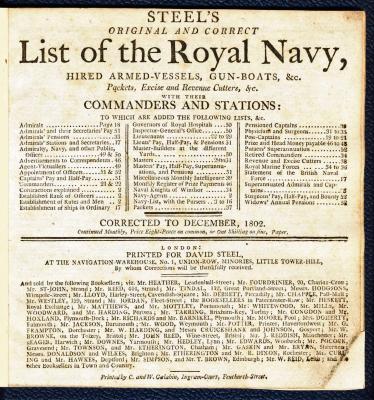 |
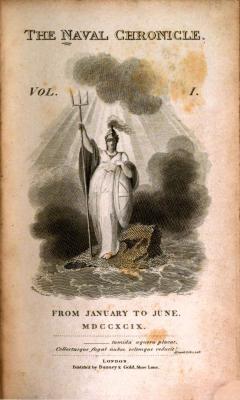 |
It is no coincidence that Anne’s first words in Persuasion commend those who serve in the Navy and challenge her father’s rank-obsessed pronouncements:
“The navy, I think, who have done so much for us, have at least an equal claim with any other set of men, for all the comforts and all the privileges which any home can give. Sailors work hard enough for their comforts, we must all allow.” (21)
Equal claims and privileges for men who work hard are precisely what Sir Walter Elliot will not allow. The roll call of officers in David Steel’s Navy List, forging their steady upward progress through action and merit, are in direct opposition to the “almost endless creations” (3) of titled dignitaries listed in Sir Walter’s book of books, the Baronetage, their social rank inherited by name or acquired with money. But Anne’s eloquence does not end on a generalization. From among the “set of men” who strive to protect the nation and estates such as Sir Walter’s, she goes on to speak with quiet confidence of one sailor’s individual claims to domestic comfort, Admiral Croft: “‘He is rear admiral of the white. He was in the Trafalgar action, and has been in the East Indies since; he has been stationed there, I believe, several years’” (24). Her knowledge of the Admiral’s involvement in Trafalgar and his being “on a foreign station” (33) with his wife in the summer of 1806 is likely to have come directly from Wentworth during their brief courtship. Subsequent readings of navy lists and the relevant pages of the Naval Chronicle together with a range of other newspapers would inform her of Admiral Croft’s movements since then.
The same sources suggest a telling connection between the fictional Croft and Wentworth and one of Jane Austen’s naval heroes, Sir Home Riggs Popham. The Chronicle (17: 209–42) carried a thirty-three page report of the five-day court martial in Portsmouth in March 1807, where Captain Popham was severely reprimanded for removing his squadron from its station without orders from the Admiralty. His reasons were judged sound by a majority of the public, and Jane Austen composed a poem in honor of this “Gallant Commander” with qualities of “Promptitude, Vigour, Success” (Later Manuscripts 246), that “true naval alertness” (P 51) embodied in the conduct of Admiral Croft and his wife on shore and in Frederick Wentworth’s self-determining exertions at sea: “His genius and ardour had seemed to foresee and to command his prosperous path” (32). Those ranged against Popham accused him of rash adventuring and spoke of his character with the same distrust that Lady Russell harboured for Wentworth’s “dangerous” self-assurance: “He was brilliant, he was headstrong” (29). HMS Asp, the name of Wentworth’s first ship, had been part of Popham’s squadron in 1798, and in the December 1814 Navy List, Popham appears, as would Admiral Croft in Anne Elliot’s copy, among the Rear-Admirals of the White.1
All newspapers of the time carried reports of military action on land and at sea, the provincial papers drawing on the national press for the most up-to-date reports. An exclusively naval periodical, the Naval Chronicle appeared in monthly editions from 1799 until 1818. As well as publishing original material, the Chronicle relied on other sources for the latest despatches, in particular The London Gazette. Captain Francis Austen’s account of the capture of La Ligurienne, written on board the Peterel on March 22, 1800, appeared initially in The London Gazette2 in May and was subsequently copied verbatim in the Chronicle’s “Letters on Service” section in July 1800 (3: 410).
As captain of the Laconia, Wentworth could expect his success off the Western Islands to be published in the same source and read by Anne Elliot. News of naval battles and prize taking was not confined to the Chronicle and Gazette. At Ashe Park, Jane Austen read of Frank’s capture of a Turkish ship in the paper belonging to her neighbor Mr. Holder and wrote to Cassandra at Godmersham Park, “You will see the account in the Sun I dare say” (8–9 November 1800). The report came three months behind the event, so it is likely that Mr. Holder’s was a local newspaper. The London Gazette made no mention of this particular exploit; neither did the Chronicle, perhaps because the Turkish vessel was deliberately destroyed to prevent its cargo falling into enemy hands. In the summer of the same year, the Chronicle published a letter written by Sir Thomas Williams, Lieutenant Charles Austen’s captain on the Endymion, itemizing the prizes taken that spring (3: 498). The proceeds from one of these prizes—and there were several relatively minor captures that year—paid for Jane and Cassandra’s topaz crosses and gold chains.
Every edition of the Chronicle included lists of new ships under construction in various dockyards; biographical memoirs; portraits and seascapes; naval anecdotes; poems on shipwrecks, storms, battles, heroism, and anxious but stoic sweethearts left behind on shore; and those items of intelligence of prime interest to Anne Elliot, lists of the killed and wounded, ship by ship; promotions and appointments; marriages and obituaries. Immediately after Wentworth’s departure, Anne begins to scan the column inches and soon learns that he “had distinguished himself, and early gained the other step in rank” (32). For eight long years, as Anne follows his progress and increasing fortune, her constancy is not in question; neither, it appears, is Wentworth’s, for “she had no reason to believe him married” (32). Keeping a close eye on the Naval Chronicle gives Anne more than authority: it supplies her with hope.
Jane Austen drew on her own knowledge of marriage announcements in the newspapers. Searching the press in 1815 for news of an acquaintance’s marriage, she wrote to a niece, “I have never seen it in the Papers. And one may as well be single if the Wedding is not to be in print” (?late February–early March 1815). Notice of her brother Frank’s union with Mary Gibson on July 24, 1806, was recorded in the August edition of the Chronicle (16: 175), but Austen would have looked in vain for her brother Charles’s marriage to Frances Palmer in Bermuda on May 18, 1807. It was not recorded in the national or local papers, the Chronicle or the Gazette, although naval marriages in Nova Scotia and Newfoundland were reported. Sadly, Fanny’s death on September 6, 1814, was among the Chronicle’s October obituaries (33: 352).
The founder of the Chronicle, James Stanier Clarke, is better known to us as the Prince Regent’s librarian, the man who welcomed Jane Austen to Carlton House in 1815. Among the topics of conversation on the occasion, surely Francis and Charles Austen were spoken of, their names being familiar to Clarke through various letters and articles published in his paper. Charles Austen’s report of his sloop, the Indian, taking as a prize La Jeune Estelle was published in the Naval Chronicle of August 1808 (20: 158). More recently, in November 1815, the same month Clarke met Jane Austen, one of Frank’s past exploits had been featured, as part of a naval biography. Clarke evidently credited Jane Austen with an understanding of naval matters since he suggested she take for her next novel the subject of a sea-going clergyman, “the Friend of some distinguished Naval Character. . . .—you can then bring foreward . . . many interesting Scenes of Character & Interest” (?21 December 1815). In an earlier letter he had proposed that Austen could write of a clergyman on land, “who should pass his time between the metropolis & the Country” (16 November 1815). Given her response to that proposal, we can guess at the nature of Austen’s unrecorded reply to this later proposal. In August 1815, five months previous to Clarke’s suggestion, she had already begun the process of creating interesting scenes more to her inclination, featuring naval characters on land and a heroine whose naval acuity matched her own.
Lord Byron’s account in The Corsair of a seagoing life rang true among those, like James Stanier Clarke, who saw naval experience as heroic. The first five lines of the poem—lines that make a nonsense of Sir Walter’s boast that “‘few navy officers . . . can have had such a range’” (20–21) as that furnished by the grounds at Kellynch—were reproduced on the front cover of the July–December 1814 volume (32) of the Chronicle:
O’er the glad waters of the dark blue sea,
Our thoughts as boundless, and our souls as free,
Far as the breeze can bear, the billows foam,
Survey our empire, and behold our home!
These are our realms, no limits to their sway—
On a cold March day in the same year that Byron’s words appeared in the Chronicle, Jane Austen reported to Cassandra that she had “read the Corsair, mended my petticoat, & have nothing else to do” (5–8 March 1814); but when the initial ideas for writing Persuasion began to supersede petticoat mending, perhaps Austen recalled not only “Byron’s ‘dark blue seas,’” subsequently admired by Anne and Benwick at Lyme (P 117), but also the lines that touch on the common female experience of waiting and hoping on shore.
The tidings spread—and gathering grows the crowd:
The hum of voices—and the laughter loud,
And woman’s gentler anxious tone is heard—
Friends’—husbands’—lovers’ names in each dear word.
“Oh! are they safe? we ask not of success—
“But shall we see them? will their accents bless?
“From where the battle roars—the billows chafe—
“They doubtless boldly did—but who are safe?
“Here let them haste to gladden and surprize,
“And kiss the doubt from these delighted eyes!” (1, 5: 107–16)
The “authority” on naval matters that fed into Austen’s writing of Persuasion did not originate primarily in newspapers or navy lists, although the location of her brothers’ ships, their promotions, battles, and prizes were reported in both. Unlike Anne Elliot, she remained in touch with the men concerned and with their contacts. She learned of Frank’s promotion from lieutenant to commander and of the ship he was to take charge of from a variety of sources: a clerk in the Navy Office, two relations by marriage, and a high-ranking naval connection.
Frank is made.—He was yesterday raised to the Rank of Commander, & appointed to the Petterel Sloop, now at Gibraltar.—A Letter from Daysh has just announced this, & as it is confirmed by a very friendly one from Mr Mathew to the same effect transcribing one from Admiral Gambier to the General, We have no reason to suspect the truth of it. (28 December 1798)
In the same letter from the Admiral came the news that “Lieut. Charles John Austen is removed to the Tamer Frigate.”
When letters from the brothers themselves arrived, the news could be as much as four months out of date, whereas newspaper reports were more or less current, and the navy lists were updated on a monthly basis. Sometimes communication was hindered by location, as Frank had warned his younger sister early in December 1798:
Frank . . . says that our correspondence cannot be so easily carried on in future as it has been, as the communication between Cadiz and Lisbon is less frequent than formerly. . . . [L]ong intervals . . . may divide his letters. (1–2 December 1798)
There is no evidence that the Austen family owned navy lists, but Jane had certainly seen copies and maybe had consulted them when either of her sailor brothers was incommunicado. A number of navy lists were available, but David Steel’s was accounted the most detailed and accurate, a fitting example of good things coming in small packages. Measuring only five-and-a-half inches square—the ideal size to smuggle into Kellynch among slim volumes of Byron’s and Scott’s poetry—it contains a plethora of fascinating detail within its fifty or so pages, as can be seen in the list of contents on its cover.
Steel, a nautical bookseller in London, had recognized a demand for up-to-the-minute information about Royal Navy ships and personnel. His unofficial lists appeared from 1780 to 1816 and proved a popular and invaluable resource throughout the wars with France and America. The earliest productions were little more than thin pamphlets, comprising an inventory of ships with the number of their guns, the names of their commanders, and an indication of whether the vessels were in commission, out of service, or under construction. By the 1790s, the lists also gave the locations of home and foreign stations, a record of vessels taken by or from the enemy, the identity of officers who had perished in the service of their country, the launch or acquirement date of each ship, and the names of the Lords of the Admiralty, Commissioners of the Navy and Navy agents, post captains, commanders, lieutenants, masters, surgeons, and officers of the Royal Marines. During the wars with France and America, Steel’s list appeared at the beginning of every month. Although unofficial, Steel’s list was accounted both accurate and trustworthy. It was not until the beginning of 1814 that the Admiralty itself began producing anything comparable, issued from Albemarle Street in London by Jane Austen’s publisher, John Murray.
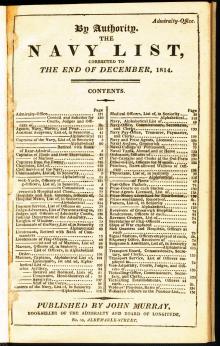 Admiralty's Navy List
Admiralty's Navy List
(Click here to see a larger version.)
The Miss Musgroves, eager to demonstrate their growing interest in Captain Wentworth, acquire a copy of the requisite list, while Anne, with the subject of her researches back on shore, no longer has need of it. Its initial significance for her arose from her relationship with Wentworth eight years previously; now the same man awakens in the Musgrove girls an awareness that such a list exists. Anne’s “comfortable feeling of superiority” over Henrietta and Louisa—“she would not have given up her own more elegant and cultivated mind for all their enjoyments” (43)—extends to a mild contempt for their sudden interest in naval matters: “she found the Miss Musgroves just fetching the navy-list,—(their own navy list, the first that had ever been at Uppercross); and sitting down together to pore over it, with the professed view of finding out the ships which Captain Wentworth had commanded” (70). The broken-up Asp does not appear in its pages:
The girls were now hunting for the Laconia; and Captain Wentworth could not deny himself the pleasure of taking the precious volume into his own hands to save them the trouble, and once more read aloud the little statement of her name and rate, and present non-commissioned class. (72)
During their feckless brother Dick’s time at sea as a midshipman, Jane Austen tells us, they had been “unobservant and incurious . . . as to the names of men and ships” (55); now, the navy list is of thrilling immediacy, but it has been of long-standing value to Anne and to Wentworth. His desire to take “the precious volume” in his hands is an early indication of the enduring connection between them and prefigures their joint attachment to the community of brother officers named in the list’s pages.
Which particular version of the list the Musgroves consult on this occasion is not specified, but Steel’s is the most probable, given that the official Admiralty list named ships but did not specify rate and class. The rate depended on the number of guns and men carried, so first rate ships had 100 guns and from 850 to 875 men; second rate 98 to 90 guns and up to 750 crew; and so on, down to unrated sloops with a maximum of 18 guns and 125 men.
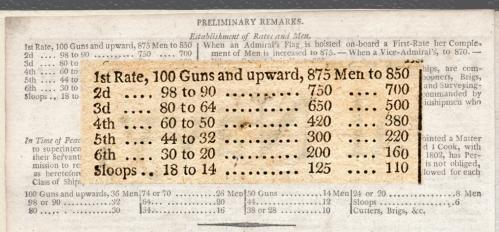 Ships' Rating
Ships' Rating
Steel’s list denoted class with a series of letters: C for commissioned, or in service at sea; O for “in ordinary” or non-commissioned, that is, out of service in port; B for building; and T for taken from the enemy.
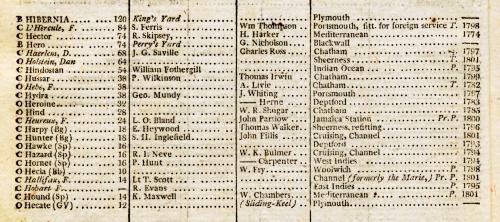 Ships' Class
Ships' Class
(Click here to see a larger version.)
From where did the Musgroves buy their navy list? Fifty booksellers are named at the foot of the cover, a number of whom were based in London, but the majority operated in coastal towns such as Portsmouth, Dartmouth, Harwich, Lynn, Yarmouth, and Brighton. The closest supplier to Uppercross, and indeed to Kellynch, is Mr. G. Frampton in Dorchester, although “other Booksellers in Town and Country” also sold Steel’s.
Like the Musgroves’ list of September 1814, that of December 1802, the first ever to be seen in my house, was produced in a brief period of peace in Europe. The Treaty of Amiens, signed on March 27, 1802, granted a cessation of hostilities for fourteen months. Eight months into the peace, 301 ships in Steel’s are recorded as in commission, on foreign stations, or in passage; 324 ships are out of commission and back in port, with a skeleton crew. A number of ordinary seamen were retained on board, according to the size of the vessel: 36 men being assigned to those with 100 guns or more; 14 men to 50 guns; and 6 men to sloops. As for the officers, those like Captains Wentworth and Benwick on decommissioned ships made their way home, as did Francis and Charles Austen. In February 1802, Charles was already on his way from Lisbon to Portsmouth in the Endymion, and by the summer, Frank was at Portsmouth on HMS Neptune, waiting to be paid off. The brothers divided their time on shore among their relations at Steventon, Bath, and Godmersham, just as Frederick Wentworth headed for his sister and brother-in-law’s house in Somerset, then followed them to Bath.
Captain Wentworth’s first ship, for which Henrietta and Louisa search in vain, appears in Steel’s list of 1802. The real Asp, built in 1794, would have been only twelve years old in 1806, had she not been scrapped in 1803, but Jane Austen dispatches Wentworth to the West Indies in a much older vessel. Launch dates in the 1750s, ’60s and ’70s are not unusual, bearing out Wentworth’s claim that ships “‘not fit to be employed’” (P 70) for action beyond home waters were sent frequently to foreign stations. In the 1802 list, Charles Austen’s Namur, to which he was promoted as flag captain in November 1811, is at Chatham “to be cut down” (11) from 90 to 74 guns. Built in 1756, it was one of the longest serving ships still in commission. The Grappler, in which Austen returns Captain Benwick to Portsmouth from the Cape as a newly made captain in August 1814, is, in the 1802 list, moored at Plymouth, and by December 1814 she has disappeared from the records. There is no mention of a Laconia in either list. There is, however, a Love & Friendship, a small gun vessel equipped in neither a loving nor friendly spirit, with two cannons.
In the “Monthly Miscellaneous Intelligence” section for December 1802 is the heading Ships Sold, broken up, &c. One of these is the sloop Scorpion, on which Charles Austen served for two years as a lieutenant, until 1798. In Anne Elliot’s copy of a list in 1808 or thereabouts, she might have seen Captain Wentworth’s worn out Asp in this section. Had Wentworth’s luck not held and the Asp been caught in the storm off Plymouth, his death would have been recorded in a short paragraph beneath the sad fate of various defunct ships. Under Lost in the 1802 list, the Fly, a sloop like the Asp, did not survive to be broken up; her unlucky commander, “Capt. Duval, is generally believed to be lost in the Atlantic, with all her crew” (39). A longer, but even less detailed, roll call of dead officers appears under Deaths.
Of prime importance to the naval families back on shore was news of promotion. What the navy list provided was a clear indication of how many men stood between an officer and his next move up the career ladder, when patronage and merit could do no more. In Steel’s list, Frank’s name appears among the thirty-one post captains made in 1800; Charles is included with the 180 lieutenants commissioned in 1797.
Given that promotion often came slowly, if at all, the capture of foreign vessels provided a welcome boost to naval officers’ incomes, especially if they had families to support. Wentworth remembers his cruise with Harville in 1806: “‘Poor Harville, sister! You know how much he wanted money—worse than myself. He had a wife.—Excellent fellow! I shall never forget his happiness’” (72).
In March 1800, Frank’s capture of the French ship La Ligurienne off Marseilles in the Peterel led to his promotion to captain of the Neptune. March proved a lucky month for the crew of the Peterel two years in succession. In March 1801, she captured the French vessels D’Alger and L’Amitie. Twenty months later, as recorded in Steel’s Navy List of December 1802, the crew finally received their due, which, shared with the crews of six other ships, did not amount to much. Frank felt his happiness as keenly as Harville when prize money awarded after his success in the Battle of St. Domingo in 1806 allowed him to marry Mary Gibson.
The final pages of Steel’s 1802 list deal with rates of pay for the various ranks, from admirals down to pursers.
 Rates of Pay
Rates of Pay
(Click here to see a larger version.)
During the peace, officers were entitled to half-pay. Fifty of the oldest captains got twelve shillings per day; the next seventy-five received ten shillings per day. Frank Austen came further down the list at eight shillings; well below the top five hundred lieutenants in the list, Charles was paid just four shillings per day. The official Admiralty Office lists did not specify rates of pay, which is probably why the original owner of my December 1814 list made his own record on the back page. In the twelve year gap between 1802 and 1814, half pay rates had risen by mere shillings.
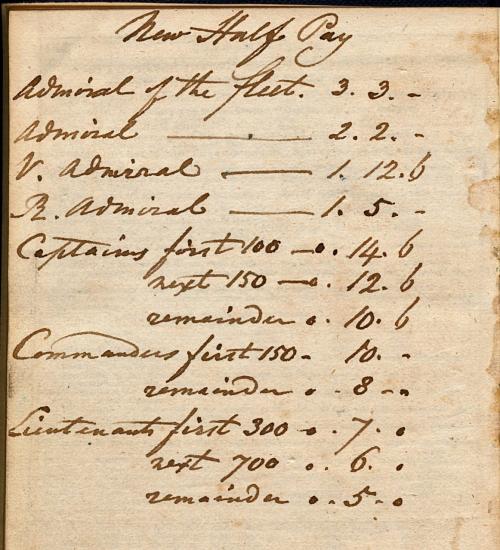 Handwritten Update to Rates of Pay
Handwritten Update to Rates of Pay
It is understandable that, deprived of the opportunity to win prize money and with little hope of promotion into dead men’s shoes, naval men on half pay should talk of “‘bad times for getting on’” (P 186) or offer up a toast for “A bloody war or a sickly season” (Southam 71). And much as they might appreciate having their husbands safe at home, naval wives had to pray for a resumption of full service and full pay, consequently suffering “the tax of quick alarm” faced by Anne Elliot (P 275). Steel’s very last section covers widows’ pensions for the different ranks, none of the amounts enough to keep body and soul together. Yet each year, the bereaved women had to state on oath that they were not in receipt of an income more than the amount of the pension.
While naval men like those in Persuasion eked out their half pay until Napoleon escaped from Elba in March 1815, others involved in a different theater of war continued to draw full pay. The peace “‘turning all our rich Navy Officers ashore’” (P 19) so confidently asserted by Mr. Shepherd did not extend to every corner of the globe. Reading the navy lists and newspapers until Wentworth’s return in the early autumn of 1814, Anne Elliot could not have ignored the continuing war with America, begun in 1812.
Captain Francis Austen was stationed off the Azores on the Elephant at the beginning of the conflict, capturing in December the American privateer schooner Swordfish, from Boston. No date is given for Wentworth’s lucrative cruise in the same location, also known as the Western Islands, where he and Harville had made money fast by taking prizes on the Laconia, but the probability is that the captured ships were privateers trading between America and the Continent. As early as 1806, a proclamation against British ships, among them Charles Austen’s Indian, citing “unlawful interruptions and vexations on trading vessels coming to the United States” (Naval Chronicle 16: 119–20), had been issued by President Thomas Jefferson and Secretary of State James Madison. That Wentworth and the Asp perpetrated a number of those “interruptions and vexations” by “‘taking privateers enough to be very entertaining’” (P 71) is made clear in the text of Persuasion. Naturally, the British saw things in a different light. The Chronicle printed Jefferson’s complaint in full as a prominent example of “American infatuation . . . as it displays, in an alarming degree, the ascendancy of French principles in the United States” (16: 119–20).
By September 1814, after two fruitless years in which neither side gained much by way of territory or ascendancy, British public opinion swung towards a settlement, since the Americans it seemed could not be beaten. Jane Austen worried that in the event of the war continuing, American sailors and soldiers would benefit from learning superior tactics from British forces. In a letter to a family friend, she set out her views and those of her brother Henry:
His veiw, & the veiw of those he mixes with, of Politics, is not chearful—with regard to an American war I mean;—they consider it as certain, & as what is to ruin us. The [?Americans] cannot be conquered, & we shall only be teaching them the skill in War which they may now want. We are to make them good Sailors & Soldiers, & [?gain] nothing ourselves.—If we are to be ruined, it cannot be helped—but I place my hope of better things on a claim to the protection of Heaven, as a Religious Nation, . . . which I cannot beleive the Americans to possess. (2 September 1814)
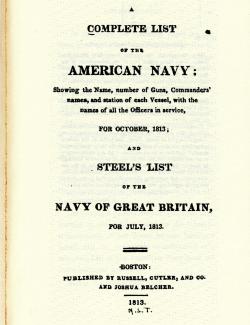 The American list is almost identical to Steel’s in both content and layout. Here are the ships, with their commanders and stations. Captains, lieutenants, masters, and marines are listed in the same way, with the egalitarian addition of the skilled lower ranks—surgeons’ mates, chaplains and pursers, boatswains and gunners, sail-makers, carpenters, and midshipmen—together with rates of pay at each level. An American Anne Elliot could follow her man’s promotions, check on his location, scan the obituaries, thrill to the reports of “British Vessels of War, Taken or Destroyed” (9–12), or lament the roll call of dead and wounded.
The American list is almost identical to Steel’s in both content and layout. Here are the ships, with their commanders and stations. Captains, lieutenants, masters, and marines are listed in the same way, with the egalitarian addition of the skilled lower ranks—surgeons’ mates, chaplains and pursers, boatswains and gunners, sail-makers, carpenters, and midshipmen—together with rates of pay at each level. An American Anne Elliot could follow her man’s promotions, check on his location, scan the obituaries, thrill to the reports of “British Vessels of War, Taken or Destroyed” (9–12), or lament the roll call of dead and wounded.
The Preface set out the publishers’ ambition to provide quarterly editions of “a more correct” version of the American navy list than had ever been attempted before and ended with the hope that “the permanent establishment of a complete list of the American Navy must receive adequate patronage” (3).
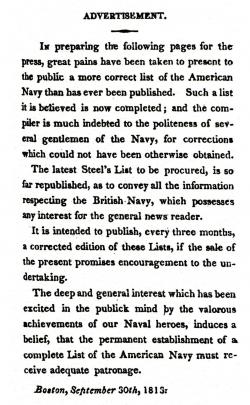 Preface to
Preface to
A Complete List of the American Navy
(Click here to see a larger version.)
Patronage, however, was not forthcoming, and no other detailed lists of this kind were published. In August 1813 a Senate resolution placed American military lists under official control, and annual naval registers were issued instead, comprising little more than officers’ names and order of seniority and a list of ships. Steel’s list, however, conveying “all the information respecting the British Navy” continued to be of interest. Newspapers such as the Boston Gazette, the National Intelligencer, and Hezekiah Niles’s Baltimore Weekly Register often gleaned material from Steel for their articles and, like English newspapers, copied reports on key naval events from each other.
The first edition of a periodical called The War, published in New York and dedicated solely to the conflict, came out on June 27, 1812, a week after hostilities opened.3 Subscribers paid $2 per annum in advance for weekly editions, carrying reports of British and American ships taken or destroyed, naval and military promotions, prize money, deaths in service, and the location of enemy ships. On Tuesday, April 13, 1813, under the heading “British Naval Force,” The War reported, “Steel’s List of the Royal Navy of Great Britain for January last, has assigned the following ships of war to the several stations undermentioned” (182), and went on to catalogue the force dispatched from England to the Bermuda station and other coastal areas, plus those ships assigned to the Western Islands.
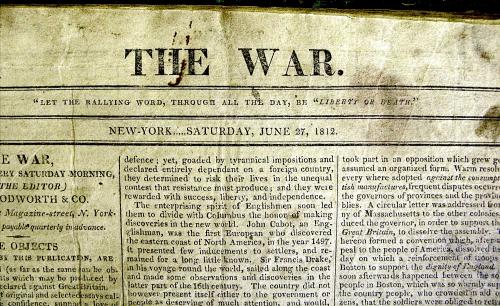
An enemy forewarned was an enemy forearmed, so when the British Admiralty woke up to the use being made of Steel’s lists, locations were omitted from its authorized data. Interestingly, an error in transcription, as well as a misspelling, names “C. J. Austin” as captain of the Elephant, when it was Frank, lurking off the Azores in the hope of catching lucrative privateers. His capture of the Swordfish in 1812 had already been reported in The London Gazette and the Naval Chronicle, so this was old news by April 1813.
|
|
|
Inaccuracies in the compilation of Steel’s lists did not escape American censure. In an article dripping with sarcasm, The War of Saturday, January 16, 1813, criticized “the loyal Mr. Steel” (who had in fact died in 1803) for being economical with the truth in failing to report the destruction of the Guerrière by the USS Constitution, even though the ship had “strangely vanished from his majesty’s service.” The piece, signed “Patriot,” ended with the rousing claim that “whether conquerors or vanquished, the intrepid and modest officers of our gallant navy will never blush at the truth, nor their country feel ashamed of its disclosure.” True to its word, three days after the capture of the Guerrière, The War of 22 August issued a list of fifty-five American vessels lost to the enemy.
What made this American victory so significant to both sides lay in the fact that it was the first naval engagement of the war. The loss of the Guerrière had not found its way into the pages of Steel’s list, but throughout the autumn and winter of 1812, the Naval Chronicle, together with every newspaper in England, reported the defeat in shocked tones. It was the first British loss to the American navy and all the worse for being a surrender. The July 1813 edition of Steel’s list eventually carried a paragraph on the disaster, stating that the Guerrière “had fought under the most disadvantageous circumstances” with “only a complement of 244 men” against the Constitution’s 476 men and 50 guns (98)—four more than she actually possessed.
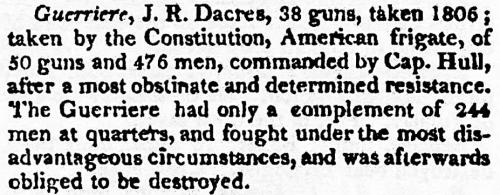
In September 1814, the same month that Anne Elliot left Kellynch for Uppercross, articles in the national press were calling on the British government to negotiate with America. The editors of the Naval Chronicle, grown weary of salvaging naval pride from irrefutable disasters, adopted a conciliatory tone in an article entitled “On Our Maritime Rights & The American Question” (32: 138).
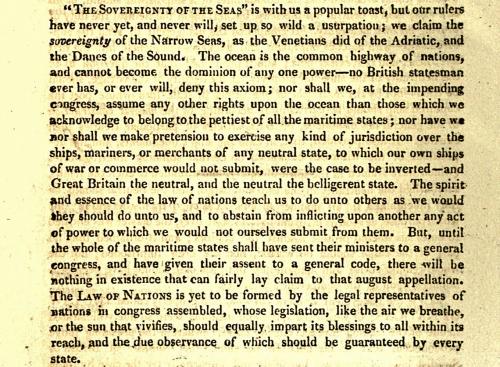
These reports probably passed Anne Elliot by. The news she desired was already in print—that the Laconia was safely decommissioned in Plymouth dockyard. At the end of September, Captain Wentworth himself stepped out from the pages of Anne’s navy lists and newspapers to test and strengthen eight long years of shared constancy and hope.
NOTES
1In Jane Austen and the Navy, Brian Southam devotes the whole of chapter 7 to Sir Home Popham, tracing several intriguing links between him and the Austen family.
2To see Frank Austen’s letter in context, visit the page in the London Gazette: https://www.thegazette.co.uk/London/issue/15255/page/443
3Copies of The War are held by the Nimitz Library (Special Collections) at the U. S. Naval Academy.
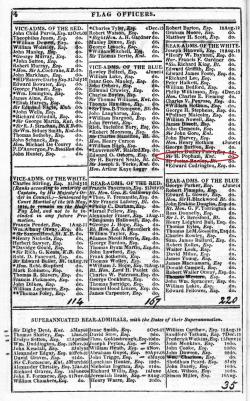
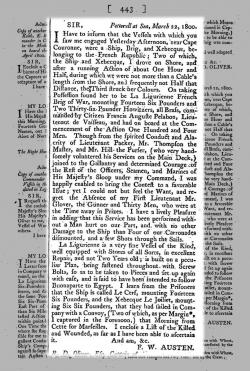 (
(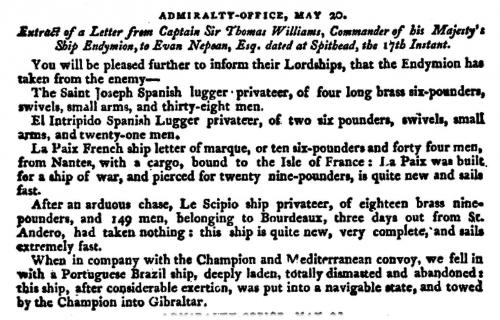 (
( (
(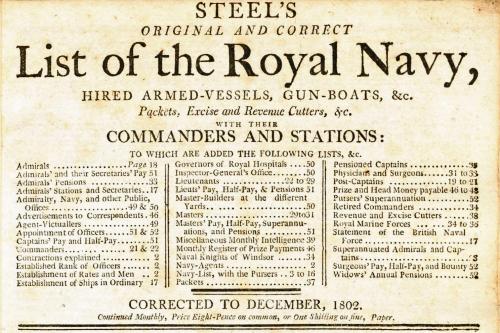 (
(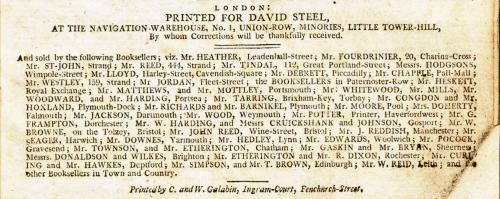 (
( (
( (
( (
(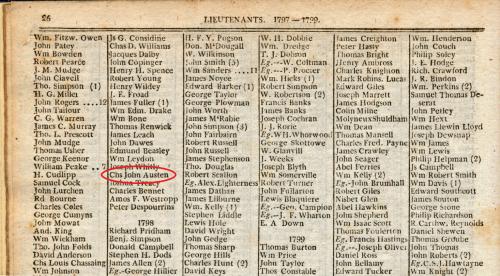 (
( (
(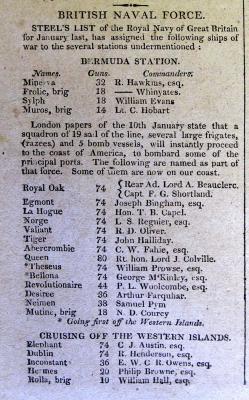 British Naval Force
British Naval Force Patriot Letter
Patriot Letter